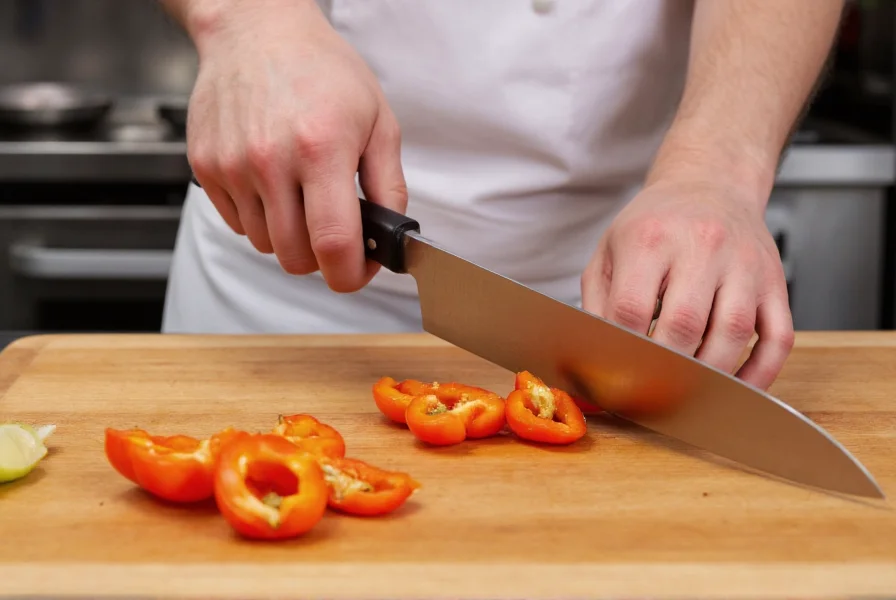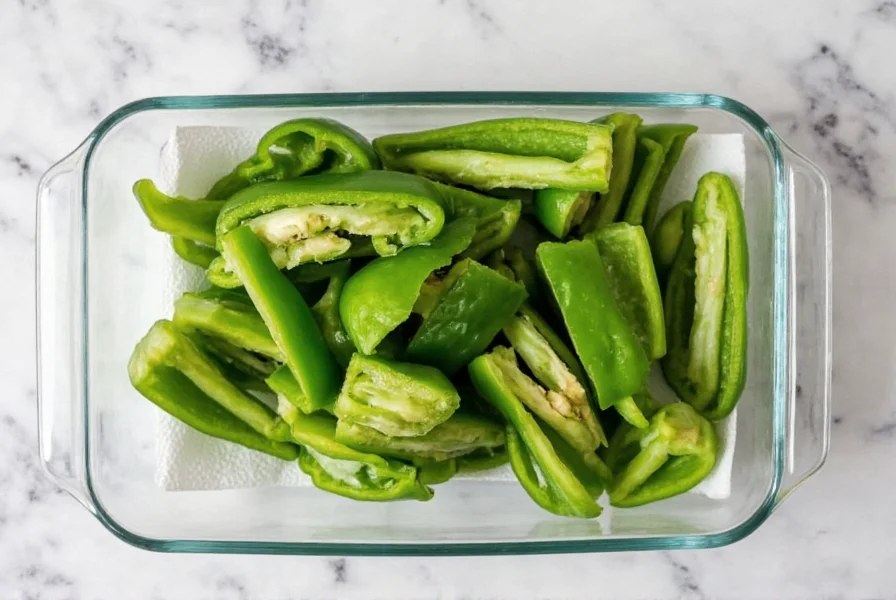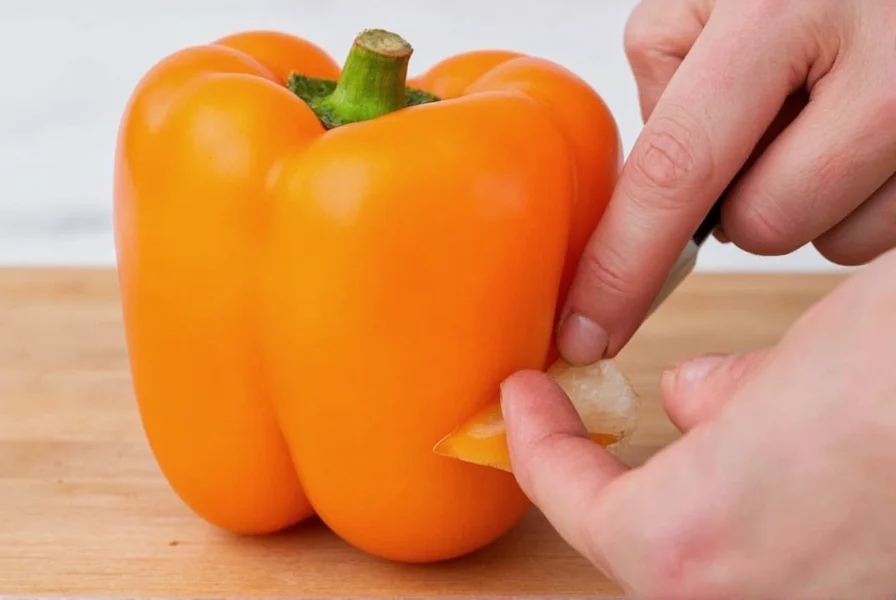The safest and most efficient way to cut bell peppers is to first slice off the top and bottom, stand the pepper upright on a stable cutting board, carefully cut away the four curved sides from the core, then slice, dice, or julienne as needed. Always use a sharp chef's knife, keep fingers curled away from the blade, and work methodically for clean, uniform pieces without injury.
Mastering bell pepper preparation transforms your cooking experience. Whether you're meal prepping for the week or crafting a gourmet dish, proper cutting technique ensures consistent results and maximizes the vegetable's vibrant flavor. Bell peppers rank among the most versatile ingredients in global cuisines, from Spanish paella to Asian stir-fries, making efficient preparation essential for home cooks.
Essential Tools for Cutting Bell Peppers
Before learning how to dice bell peppers for fajitas or julienne them for stir-fries, gather these kitchen essentials:
- Sharp 8-inch chef's knife (dull blades increase slipping risk)
- Stable cutting board (wood or composite)
- Bowl for seed disposal
- Damp towel to secure cutting board
Professional chefs emphasize that knife sharpness directly impacts safety—a sharp blade requires less pressure and provides better control. Always inspect your knife for nicks before starting. For those wondering how to safely cut bell peppers without injury, proper tool selection forms the foundation of safe preparation.
Step-by-Step: The Four-Side Method
This industry-standard technique minimizes waste and maximizes yield. Follow these steps for perfect bell pepper pieces every time:
- Prepare your workspace: Place a damp towel under your cutting board to prevent slipping. Position yourself with stable footing.
- Trim ends: Slice 1/4 inch from both the stem and blossom ends using a rocking knife motion.
- Remove core: Stand pepper upright. Carefully cut along the natural curve where the flesh meets the white ribs, working around the entire pepper to separate the four distinct lobes.
- Flatten sections: Lay each lobe skin-side down and slice away any remaining ribs and seeds.
- Cut to desired shape: Rotate pieces 90 degrees for uniform dicing, or slice lengthwise for julienne strips.

Specialized Cutting Techniques
Different recipes require specific cuts. Understanding how to julienne bell peppers for stir fry versus dicing them for salads makes a significant difference in your final dish.
| Cutting Style | Best For | Technique Tips |
|---|---|---|
| Dicing (1/4") | Salsas, fajitas, stuffing | Stack flattened pieces, make parallel cuts, then rotate and dice |
| Julienne (matchstick) | Stir-fries, garnishes | Cut lengthwise into 1/8" strips before dicing |
| Ring Slices | Burgers, pizzas, salads | Cut horizontally through whole pepper after trimming ends |
| Boat Shape | Stuffed peppers | Cut vertically around seeds, remove core while maintaining shape |
Safety First: Avoiding Common Mistakes
Many kitchen injuries occur during vegetable preparation. When learning how to safely cut bell peppers without injury, remember these critical safety points:
- Hand positioning: Use the "claw grip"—curl fingertips inward while guiding the pepper
- Cutting rhythm: Maintain steady, controlled motions rather than rushing
- Board stability: Never cut on unstable surfaces or near sink edges
- Distraction management: Complete cutting before attending to other tasks
For parents teaching children how to cut bell peppers, consider using plastic knives for initial practice. The white ribs contain most of the pepper's bitterness, so thorough removal improves flavor—this addresses the common question about the best way to remove seeds from bell peppers effectively.
Storage Tips for Cut Bell Peppers
Properly stored cut peppers maintain freshness for meal prep. After mastering how to dice bell peppers for fajitas, maximize shelf life with these methods:
- Store in airtight container with paper towel to absorb moisture
- Refrigerate within two hours of cutting
- Consume within 3-4 days for peak quality
- Freeze diced peppers on baking sheet before transferring to bags

Advanced Tips from Professional Kitchens
Chefs optimize bell pepper usage through these professional techniques:
- Color rotation: Use different colored peppers in sequence for visual appeal in dishes
- Seed preservation: Save seeds for gardening—they germinate better when fresh
- Waste reduction: Simmer cores and seeds for vegetable stock base
- Texture control: Soak cut peppers in ice water for 10 minutes for crisper texture
Understanding the proper technique for slicing bell peppers transforms ordinary ingredients into culinary assets. Whether preparing for weekly meal prep or special occasions, these methods ensure efficiency and safety in your kitchen workflow.
Frequently Asked Questions
What's the fastest way to remove seeds from bell peppers?
The quickest method involves slicing off both ends, standing the pepper upright, and cutting along the natural seams to remove the four main sections. This approach separates the seed core in one motion, eliminating the need to scrape seeds individually. For maximum efficiency when preparing multiple peppers, work through an entire batch of one step before moving to the next.
Can I use a serrated knife to cut bell peppers?
While possible, serrated knives aren't recommended for bell peppers. Their sawing motion crushes rather than slices the delicate flesh, causing juice loss and uneven cuts. A sharp 6-8 inch chef's knife provides cleaner cuts with less cellular damage, preserving texture and flavor. If your regular knife isn't sharp, consider professional sharpening rather than substituting with a serrated blade.
Why do my bell peppers become soggy after cutting?
Sogginess typically occurs from improper storage. Bell peppers release moisture when cut, which accumulates in containers. Prevent this by placing cut peppers in a single layer on a paper towel inside an airtight container. The paper towel absorbs excess moisture while maintaining proper humidity levels. Never wash peppers before storage, as added water accelerates deterioration.
How can I prevent my hands from burning after cutting hot peppers?
Bell peppers themselves don't cause burning, but if preparing alongside hot varieties like jalapeños, wear disposable gloves during cutting. If you experience burning sensation, wash hands with cold water and soap immediately—avoid hot water which opens pores. For persistent irritation, rub hands with lemon juice or vinegar before washing. Never touch your face during pepper preparation.
What's the best way to cut bell peppers for stuffed pepper recipes?
For stuffed peppers, cut horizontally about 1/2 inch below the stem to create a lid. Carefully remove seeds and membranes while preserving the pepper's structural integrity. Scoring the inside bottom in a crisscross pattern helps heat distribution during cooking. Choose bell peppers with flat bottoms that stand upright without tipping for best results. Reserve the tops for garnish or dice them for your filling mixture.











 浙公网安备
33010002000092号
浙公网安备
33010002000092号 浙B2-20120091-4
浙B2-20120091-4